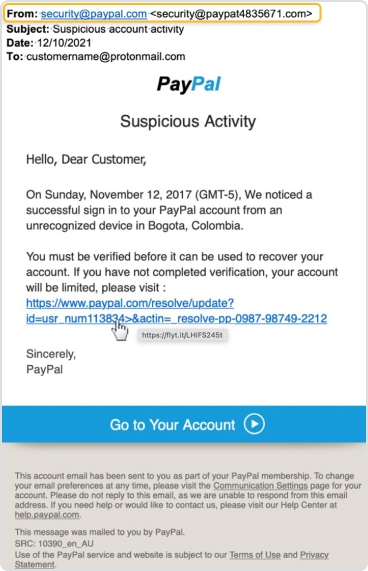Definition
💡 Spoofing is a cybercrime that has several types, including email and IP spoofing. With this scam, attackers disguise email addresses or IP addresses to make them look like they are from trusted or legitimate sources.
Example
Spoofing varies, depending on the type used by attackers. You may get an email from “PayPal” or “Netflix” encouraging you to click a link to update your account details or review your activity.


How does spoofing work?
These attacks rely on the “spoof,” or the bogus email or website, and social engineering. The latter is what prompts potential victims to take a certain action.
How they work will depend on the type of attack. Below are some common types:
- Email spoofing – The attacker will impersonate a trusted contact and then send a message that often contains malicious links or infected attachments.
- Caller ID spoofing – Attackers will disguise their phone number and use a more familiar one. They’ll then trick the victim into revealing sensitive information like passwords or banking details.
- IP spoofing – Scammers will change their IP address to hide their identity or impersonate a different user.
- URL spoofing – This involves creating fake websites (often with almost the same URLs) that look like legitimate sites. With this scam, the victims are tricked into believing that the site is trusted. These may use URLs like “www.abcd0.com” instead of “www.abcdo.com.”
What type of attack relies on spoofing?
Phishing relies on spoofing. However, they are two distinct cyberattack types.
Phishing:
- Is an attack type
- Focuses on stealing personal information
Spoofing:
- Is more of a means to execute a cyberattack
- Relies on the attacker impersonating someone else’s identity
How to stop spoofing emails from my email address
Spoofing emails are often easy to detect. To recognize one, here are some things to be aware of:
- If the message asks for sensitive information or contains suspicious attachments that you didn’t ask for, it may be a scam email.
- If an email starts with a generic greeting, instead of a personalized message, then it may be a scam attempt.
- Check the message carefully. If it contains spelling, grammar mistakes, or other glaring errors, it’s likely a fraudulent attempt.
Additionally, to protect yourself against fraud messages:
- Never click a suspicious or an unsolicited link
- Use a strong password
- Check the email header to make sure that all the details match
- Set up a spam filter
- Keep your inbox organized.


